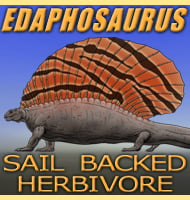
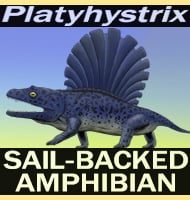
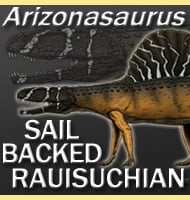
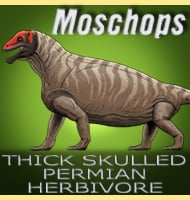
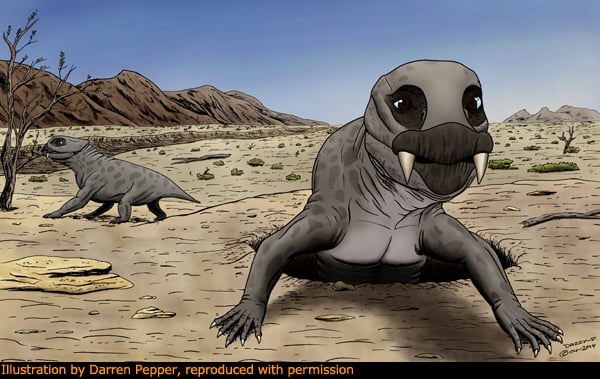
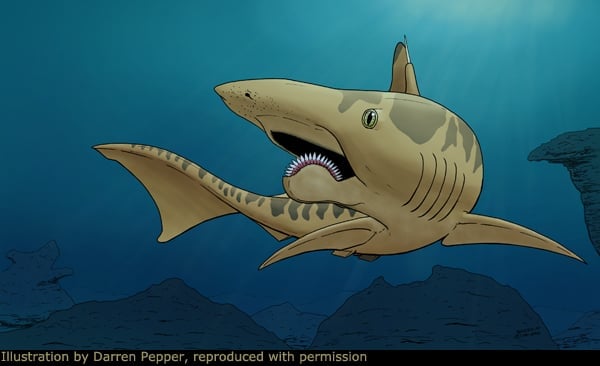
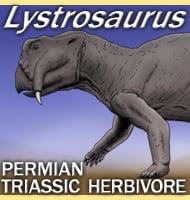
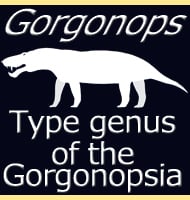

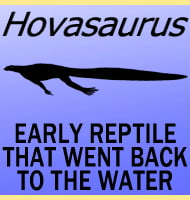
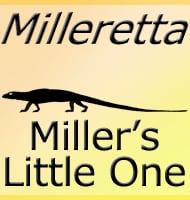
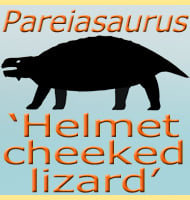
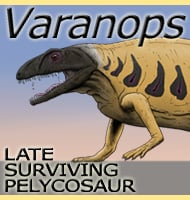
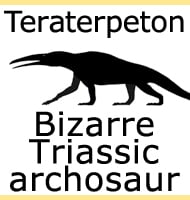
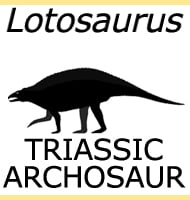
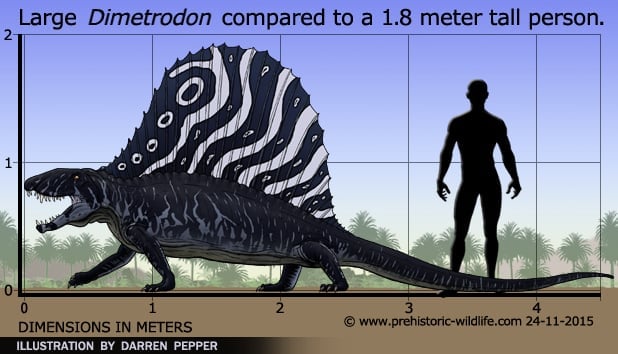
Name: Dimetrodon(Zweifachgebiss).
Phonetisch: Di-met-ro-don.
Benannt von: Edward Drinker Cope – 1878.
Synonyme: Bathyglyptus, Bathygnathus?,Embolophorus, Eosyodon,Theropleura.
Klassifikation: Chordata, Tetrapoda, Amniota,Synapsida, Pelycosauria, Sphenacodontidae.
Spezies: D. angelensis, D. booneorum, D.borealis, D.dollovianus, D. fritillus, D. giganhomogenes, D. gigas, D. grandis, D.limbatus, D. loomisi, D. macrospondylus, D. milleri, D. natalis, D.occidentalis, D. platycentrus, D. teutonis.
Ernährung: Fleischfresser.
Größe: Je nach Art zwischen 1,7 und4,6 Meter lang.
Bekannte Fundorte: Deutschland -Tambach Formation. USA,New Mexico – Cutler Formation; Oklahoma – Garber Formation, HennesseyFormation, Wellington Formation; Texas – Arroyo Formation, AdmiralFormation, Bead Mountain Formation, Belle Plains Formation, NoconaFormation, Petrolia Formation, Putnam Formation, Vale Formation,Waggoner Ranch Formation.
Zeitabschnitt: Artinskian bis zum Roadian des Perms.
Fossile Darstellung: Viele Exemplare wurden gefunden, so dass die Morphologie des Dimetrodon leicht zu bestimmen ist.
Oft als Dinosaurier betrachtet, war der Dimetrodon eigentlich einer der Pelycosaurier und ging den frühesten Dinosauriern um mehrere Millionen Jahre voraus. Seine Popularität rührt von dem massiven Segel her, das er hochkant auf dem Rücken trägt. Der genaue Zweck dieses Segels ist noch unbekannt, aber es wurde spekuliert, dass es zu Schauzwecken diente, entweder um Artgenossen anzulocken oder Rivalen einzuschüchtern. Eine andere Theorie ist, dass er zur Temperaturregulierung diente. Kaltblüter sind immer träge, bis sie ihre Körpertemperatur erhöhen können. Wenn Dimetrodon Blut in sein Segel gespült hätte, um seine Temperatur zu erhöhen, hätte es einen bedeutenden Vorteil gegenüber seinen Beutetieren gehabt, die noch zu langsam und träge gewesen wären, um zu flüchten. Es ist natürlich völlig plausibel, dass beide Theorien richtig sind.
Dimetrodon hatte ein sehr erfolgreiches Raubtierdesign und seine große Ausdehnung in der Zeitlinie des Fossilnachweises und die geographische Verteilung der Überreste sind ein Beweis dafür. Abgesehen von dem potentiellen Vorteil der kontrollierten Thermoregulation hatte Dimetrodon zwei verschiedene Arten von Zähnen, daher der Name. Das Gebiss bestand aus Zähnen zum Greifen der Beute und Zähnen zum Scheren des Fleisches, wobei die Zähne auch eine sehr feine Zahnung aufwiesen, die ursprünglich als Risse gedacht waren. Abgesehen von einer effizienteren Tötung hätten diese Zähne Dimetrodon in die Lage versetzt, mit dem Verzehr seiner Beutetiere kurzen Prozess zu machen. Frühere Exemplare von Dimetrodon erscheinen kleiner als die späteren Fossilien.
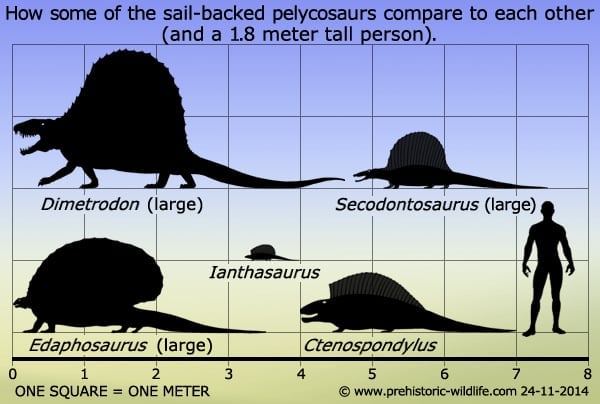
Ctenospondylus,Dimetrodon,Edaphosaurus,Ianthasaurus,Secodontosaurus.
Weitere Literatur
– Descriptions of extinct Batrachia and Reptilia from the Permianformations of Texas. – Proceedings of the American PhilosophicalSociety 17:505-530. – Edward Drinker Cope – 1878.
– The history of the Pelycosauria, with a description of the genusDimetrodon, Cope. – Transactions of the AmericanPhilosophical Society20 (1): 5-62. – G. Baur & E. C. Case – 1899.
– Notes on the Permo-Carboniferous reptile Dimetrodon.- The Journal ofGeology 35 (8): 673-689. – A. S. Romer – 1927.
– The skeleton of an immature pelycosaur, Dimetrodoncf. grandis, fromthe Permian of Texas. – Journal of Paleontology 16 (4): 485-486. – C.W. Sternberg – 1942.
– The San Angelo Formation, Permian of Texas, and its vertebrates.
The Journal of Geology 61 (5): 389-423. – E. C. Olsen & J. R.Beerbower – 1953.
– Parallelism in the evolution of the Permian reptilian faunas of theOld and New Worlds. – Fieldiana 37 (13): 385-401. – Everett C. Olson -1955.
– Comparison of the Early Permian vertebrate faunas of the Four Cornersregion and north-central Texas. – Los Angeles County Museum of NaturalHistory Contributions in Science 105: 1-13. – P. P. Vaughn – 1966.
– Early Permian vertebrates from southern New Mexico and theirpaleozoogeographic significance. – Los Angeles County Museum of NaturalHistory Contributions in Science 166: 1-22.. – P. P. Vaughn – 1969.
– Eine neue Art von Dimetrodon (Reptilia,Pelycosauria) aus einer anondeltaischen Fazies im Unterperm von Nord-Zentral New Mexico. -Journal of Paleontology 51 (1): 108-115. – D. S. Berman – 1977.
– A thermal model of the sailback pelycosaur. – Paleobiology 12 (4):450-458. – S. C. Haack – 1986.
– Eine neue Art von Dimetrodon (Synapsida:Sphenacodontidae) aus dem Unterperm von Deutschland belegt das erste Vorkommen der Gattung außerhalb Nordamerikas. – Canadian Journal of Earth Sciences 38: 803-812. – D.S. Berman, R. R. Reisz, T. Martens & A. C. Henrici – 2001.
– Natural environment and thermal behaviour of Dimetrodonlimbatus. -Journal of Thermal Biology 26 (1): 15-20. – G. A. Florides, S. A.Kalogirou, S. A. Tassou & L. Wrobel – 2001.
– Histological analysis of traumatic injury to multiple neural spinesof an associated skeleton of Dimetrodon:Implications for healingresponse, dorsal sail morphology and age-at-death in a Lower Permiansynapsid. – Integrierte Vergleichende Biologie 44: 628. – E. A. Rega, K.Noriega, S. Sumida & A. Lee – 2004.
– Evidence-based paleopathology I: Ontogenetic and functionalimplications of dorsal sails in Dimetrodon. – Journal of VertebratePaleontology 25 (S3): 103A. – E. Rega, S. Sumida, K. Noriega, C. Pell& A. Lee – 2005.
– Evidence-based paleopathology II: Impact on phylogenetic analysis ofthe genus Dimetrodon. – Journal of VertebratePaleontology 25 (S3):120A. – S. Sumida, E. Rega & K. Noriega – 2005.
– A new record of the Early Permian pelycosaurian-grade synapsidDimetrodon (Eupelycosauria: Sphenacodontidae) fromthe Lower CutlerGroup (Early Permian) of Jemez Pueblo, north-central New Mexico. -Journal of Vertebrate Paleontology 27 (3, Suppl.): 110A. – K. Madalena,S. Sumida, K. Zeigler & E. Rega – 2007.
– Evolution of bone microanatomy of the tetrapod tibia and its use inpalaeobiological inference. – Journal of Evolutionary Biology 21 (3):807-826. – A. Kriloff, D. Germain, A. Cranoville, P. Vincent, M. Sache& M. Laurin – 2008.
– Dimetrodon (Amniota: Synapsida: Sphenacodontidae)from the LowerPermian Abo Formation, Socorro County, New Mexico. – New MexicoGeological Society Guidebook 60. New Mexico Geological Society. pp.281-284. – S. G. Lucas, J. A. Spielmann, L. F. Rinehart & T.Martens – 2009.
– Comparative anatomy and osteohistology of hyperelongate neural spinesin the sphenacodontids Sphenacodon and Dimetrodon(Amniota: Synapsida).- Journal of Morphology 271 (12): 1407-1421. – A. K. Huttenlocker, E.Rega & S. S. Sumida – 2010.
– Healed Fractures in the Neural Spines of an Associated Skeleton ofDimetrodon: Implications for Dorsal Sail Morphologyand Function. -Fieldiana Life and Earth Sciences 5: 104. – E. A. Rega, K. Noriega, S.S. Sumida, A. Huttenlocker, A. Lee & B. Kennedy – 2012.
—————————————————————————-
Zufallsfavoriten
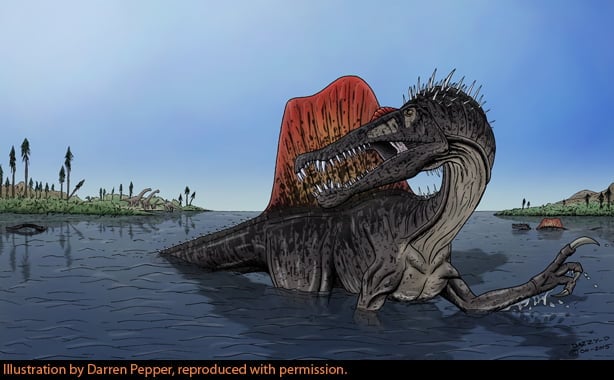 |
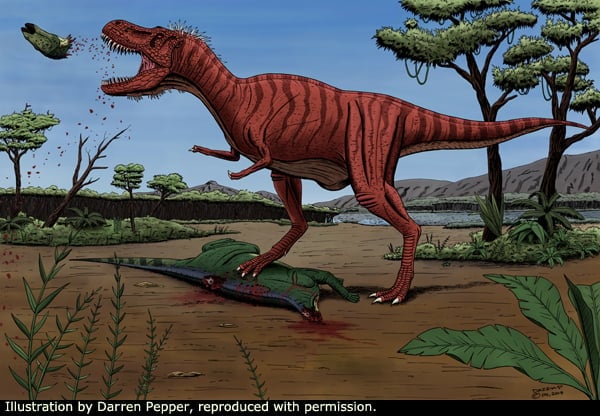 |
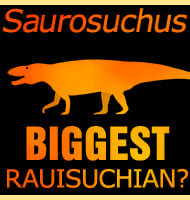 |
Datenschutz& Cookies Policy